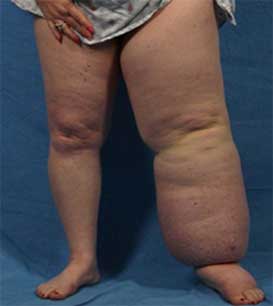Resumo
Definição
História e exame físico
Principais fatores diagnósticos
- história de malignidade
- história de viagens a áreas com filariose endêmica
- história de cirurgia prévia
- história de radioterapia
- edema indolor unilateral de membro ou genitália
- envolvimento do membro distal
- sinal de Stemmer positivo
Outros fatores diagnósticos
- história de traumatismo penetrante na axila ou na virilha
- peso e/ou fraqueza nos membros
- edema não depressível
- alterações cutâneas
- história familiar de linfedema
Fatores de risco
- tratamento de câncer
- infecção por nematódeos (filariose)
- cirurgia perto de linfonodos axilares ou inguinais
- estádio avançado de tumor, nódulo e metástase (TNM)
- radioterapia
- trauma
- cicatrizes curvilíneas
- história familiar de linfedema
- síndrome genética
- obesidade
- insuficiência venosa crônica
Investigações diagnósticas
Primeiras investigações a serem solicitadas
- linfocintilografia
Investigações a serem consideradas
- ressonância nuclear magnética (RNM) do membro afetado
- tomografia computadorizada (TC) do membro afetado
- exame de imagem fluorescente quase infravermelho
- linfangiografia
- esfregaço de sangue para filariose
- teste genético
Algoritmo de tratamento
todos os pacientes
Colaboradores
Autores
Arin K. Greene, MD, MMSc

Department of Plastic and Oral Surgery
Boston Children's Hospital
Director Lymphedema Program
Vascular Anomalies and Pediatric Plastic Surgery Endowed Chair
Professor of Surgery
Harvard Medical School
Boston
MA
Disclosures
AKG declares that he has no competing interests. AKG is an author of a number of references cited in this topic.
Aladdin Hassanein, MD, MMSc, FACS
Associate Professor
Division of Plastic Surgery
Indiana University School of Medicine
Indianapolis
IN
Disclosures
AH declares that he has no competing interests. AH is a principal investigator in active grants on lymphoedema from the United States National Institute of Health (R21, K08), Plastic Surgery Foundation, Indiana University Health.
Acknowledgements
Dr Arin K. Greene and Dr Aladdin Hassanein would like to gratefully acknowledge Dr Reid A. Maclellan, Dr Sumner A. Slavin, and Dr Carolyn C. Schook, previous contributors to this topic.
Disclosures
RAM, SAS, and CCS are authors of a number of references cited in this topic.
Peer reviewers
Hakan Brorson, MD, PhD
Senior Consultant Plastic Surgeon
Department of Plastic and Reconstructive Surgery
Lund University
Malmoe University Hospital
Malmoe
Sweden
Disclosures
HB is an author of a number of references cited in this topic.
Neil R. Feins, MD
Professor
Harvard Medical School
Senior Surgeon
Children's Hospital Boston
Boston
MA
Disclosures
NRF declares that he has no competing interests.
Peer reviewer acknowledgements
BMJ Best Practice topics are updated on a rolling basis in line with developments in evidence and guidance. The peer reviewers listed here have reviewed the content at least once during the history of the topic.
Disclosures
Peer reviewer affiliations and disclosures pertain to the time of the review.
References
Key articles
Brix B, Sery O, Onorato A, et al. Biology of lymphedema. Biology (Basel). 2021 Mar 25;10(4):261.Full text Abstract
Manrique OJ, Bustos SS, Ciudad P, et al. Overview of lymphedema for physicians and other clinicians: a review of fundamental concepts. Mayo Clin Proc. 2020 Aug 20:S0025-6196(20)30033-1.Full text Abstract
Executive Committee of the International Society of Lymphology. The diagnosis and treatment of peripheral lymphedema: 2020 consensus document of the International Society of Lymphology. Lymphology. 2020;53(1):3-19.Full text Abstract
Reference articles
A full list of sources referenced in this topic is available to users with access to all of BMJ Best Practice.

Differentials
- Insuficiência venosa crônica
- Trombose venosa profunda (TVP)
- Lipedema
More DifferentialsGuidelines
- All-Ireland lymphoedema guidelines for the diagnosis, assessment and management of lymphoedema 2022
- The diagnosis and treatment of peripheral lymphedema
More GuidelinesPatient information
Câncer de mama localmente avançado: o que é?
Câncer de mama localmente avançado: quais são as opções de tratamento?
More Patient informationVideos
Explicação sobre malhas de compressão
More videosLog in or subscribe to access all of BMJ Best Practice
Use of this content is subject to our disclaimer